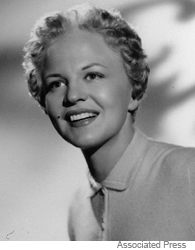Peggy Lee was a prolific, Grammy Award-winning vocalist, Academy Award-nominated actress and songwriter. Renowned for her emotive voice and sensual delivery, her most famous contributions to music include her hits “Fever” and “Is That All There Is?”
Peggy Lee’s Early Days
Peggy Lee was born Norma Deloris Egstrom on May 26, 1920, in Jamestown, North Dakota. At age 14, she started performing with a local band, The Doc Haines Orchestra, and singing with them for radio stations. While the program director at WDAY in Fargo was fond of Egstrom’s voice, he liked her name less. He decided she looked “like a Peggy,” and renamed her Peggy Lee.
Lee was “discovered” one day in her late teens while singing at a supper club on Chicago’s Gold Coast. The legendary Benny Goodman happened to be in town, and stopped by to hear Lee sing at his wife’s request. The performance impressed him so much that he asked her to join his band the next day.
“Miss Peggy Lee,” as she later insisted on being called, continued to develop her musical stylings and stage presence with every career move she made. Her delivery differed from other singers of the time, who had a propensity for forceful, emotional displays.
“In a world of belters,” The New York Times wrote, “she was a minimalist who eliminated any hint of the extraneous in both her voice and gestures, and she could stir audiences with an understated phrase more than most singers could by shouting and stomping.”
Sources in this Story
- Songwriters Hall of Fame: Miss Peggy Lee
- The New York Times: Peggy Lee
- The official site of Miss Peggy Lee
- NPR: Delving into Peggy Lee’s Steamy Mystique
- Craig’s Big Bands & Big Names.com: Peggy Lee at the Copacabana, 1958
- The Guardian: Peggy Lee
Peggy Lee’s Singing and Acting Career
Nominated for 12 Grammy Awards, and the winner of a Lifetime Achievement Award, Peggy Lee had multiple chart-topping hits during her career. She also accumulated a long list of television and film appearances, all covered in detail on Miss Lee’s official Web site.
One of her most heralded performances was that of an “alcoholic chanteuse” in “Pete Kelly’s Blues,” for which she earned an Academy Award nomination. Others may recognize Peggy’s voice in Walt Disney’s “Lady and the Tramp.” She sang four songs for that film, including “The Siamese Cat Song” and “La La Lu.”
Lee’s signature tune was “Fever,” described by NPR as a “slinky and inimitable” number. Peter Richmond details Lee’s life in a biography bearing the same title. Listen to “Fever” and two other hits by Lee, “Is That All There Is?” and “Why Don’t You Do Right?” at NPR’s web site.
The Woman and Her Work
- “Fever: The Life and Music of Miss Peggy Lee” by Peter Richmond
- “The Best of Miss Peggy Lee” (CD)
- “Pete Kelly’s Blues” (DVD)
The Rest of the Story
Peggy Lee’s career spanned six decades, illustrating her adaptability and willingness to push the boundaries of vocal performance, but the emergence of rock ’n’ roll proved a challenge to jazz music. In 1958, Lee’s publicity agent dubbed her “The New Peggy Lee,” and to add freshness to her image, she changed her hairstyle and wore a $12,000 wardrobe fashioned by couturiers like Princess Mariosa and Don Loper.
Lee died in 2002 at the age of 81, but her legacy lives on. In her obituary, The Guardian remembered her carefully orchestrated stage style: “She cultivated every move she made on stage, from the curl of a lip to the arch of an eyebrow, to the breathily receding resolving note of a song—and it all showed, you couldn’t be fooled that this stuff happened because she had just thought of it.”
This article was originally written by Lindsey Chapman; it was updated May 5, 2017.











